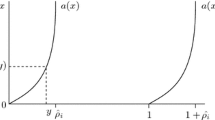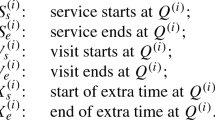Abstract
We study asymmetric polling systems where: (i) the incoming workflow processes follow general Lévy-subordinator statistics; and, (ii) the server attends the channels according to the gated service regime, and incurs random inter-dependentswitchover times when moving from one channel to the other. The analysis follows a dynamical-systems approach: a stochastic Poincaré map, governing the one-cycle dynamics of the polling system is introduced, and its statistical characteristics are studied. Explicit formulae regarding the evolution of the mean, covariance, and Laplace transform of the Poincaré map are derived. The forward orbit of the map’s transform – a nonlinear deterministic dynamical system in Laplace space – fully characterizes the stochastic dynamics of the polling system. This enables us to explore the long-term behavior of the system: we prove convergence to a (unique) steady-state equilibrium, prove the equilibrium is stationary, and compute its statistical characteristics.
Similar content being viewed by others
References
J. Bertoin, Lévy Processes (Cambridge Univ. Press, Cambridge, 1996).
D. Bertsimas and G. Mourtzinou, Decomposition results for general polling systems and their applications, Queueing Systems 31(3/4) (1999) 295–316.
S.C. Borst and O.J. Boxma, Polling models with and without switchover times, Oper. Res. 45(4) (1997) 536–543.
O.J. Boxma, Analysis and optimization of polling systems, in: Queueing, Performance and Control in ATM, eds. J.W. Cohen and C.D. Pack (North-Holland, Amsterdam, 1991) pp. 173–183.
R.B. Cooper, Queues served in cyclic order: waiting times, Bell System Tech. J. 49 (1970) 399–413.
R.B. Cooper and G. Murray, Queues served in cyclic order, Bell System Tech. J. 48 (1969) 675–689.
R.B. Cooper, S.C. Niu and M.M. Srinivasan, A decomposition theorem for polling models: The switchover times are effectively additive, Oper. Res. 44 (1996) 629–633.
M. Eisenberg, Two queues with changeover times, Oper. Res. 19 (1971) 386–401.
M. Eisenberg, Queues with periodic service and changeover times, Oper. Res. 20 (1972) 440–451.
P. Embrechts and M. Maejima, Selfsimilar Processes (Princeton Univ. Press, Princeton, 2002).
D. Grillo, Polling mechanism models in communication systems – some applications and examples, in: Stochastic Analysis of Computer and Communication Systems, ed. H. Takagi (North-Holland, Amsterdam, 1990) pp. 659–698.
A.G. Konheim, H. Levy and M.M. Srinivasan, Descendant set: An efficient approach for the analysis of polling systems, IEEE Trans. Commun. 42 (1994) 1245–1253.
A. Lasota and M.C. Mackey, Chaos, Fractals, and Noise, 2nd ed. (Springer, Berlin, 1994).
H. Levy and M. Sidi, Polling systems: Applications, modeling, and optimization, IEEE Trans. Commun. 38 (1990) 1750–1760.
C. Mack, T. Murphy and N.L. Webb, The efficiency of N machines unidirectionally patrolled by one operative when walking times and repair times are constants, J. Roy. Statist. Soc. B 19 (1957) 166–172.
J.A.C. Resing, Polling systems and multitype branching processes, Queueing Systems 13(4) (1993) 409–426.
M.P. Singh and M.M. Srinivasan, Exact analysis of state-dependent polling model, Queueing Systems 41 (2002) 371–399.
M.M. Srinivasan, S.C. Niu and R.B. Cooper, Relating polling models with nonzero and zero switchover times, Queueing Systems 19 (1995) 149–168.
L. Takács, Two queues attended by a single server, Oper. Res. 16 (1968) 639–650.
H. Takagi, Analysis of Polling Systems (MIT Press, Cambridge, MA, 1986).
H. Takagi, Queueing analysis of polling systems: An update, in: Stochastic Analysis of Computer and Communication Systems, ed. H. Takagi (North-Holland, Amsterdam, 1990) pp. 267–318.
H. Takagi, Application of polling models to computer networks, Comput. Networks ISDN Systems 22 (1991) 193–211.
H. Takagi, Queueing analysis of polling models: Progress in 1990–1994, in: Frontiers in Queueing: Models and Applications in Science and Engineering, ed. J.H. Dshalalow (CRC Press, Boca Raton, FL, 1997) pp. 119–146.
U. Yechiali, Analysis and control of polling systems, in: Performance Evaluation of Computer and Communication Systems, eds. L. Donatiello and R. Nelson (Springer, Berlin, 1993) pp. 630–650.
Author information
Authors and Affiliations
Corresponding author
Rights and permissions
About this article
Cite this article
Eliazar, I. Gated Polling Systems with Lévy Inflow and Inter-Dependent Switchover Times: A Dynamical-Systems Approach. Queueing Syst 49, 49–72 (2005). https://doi.org/10.1007/s11134-004-5555-7
Issue Date:
DOI: https://doi.org/10.1007/s11134-004-5555-7




